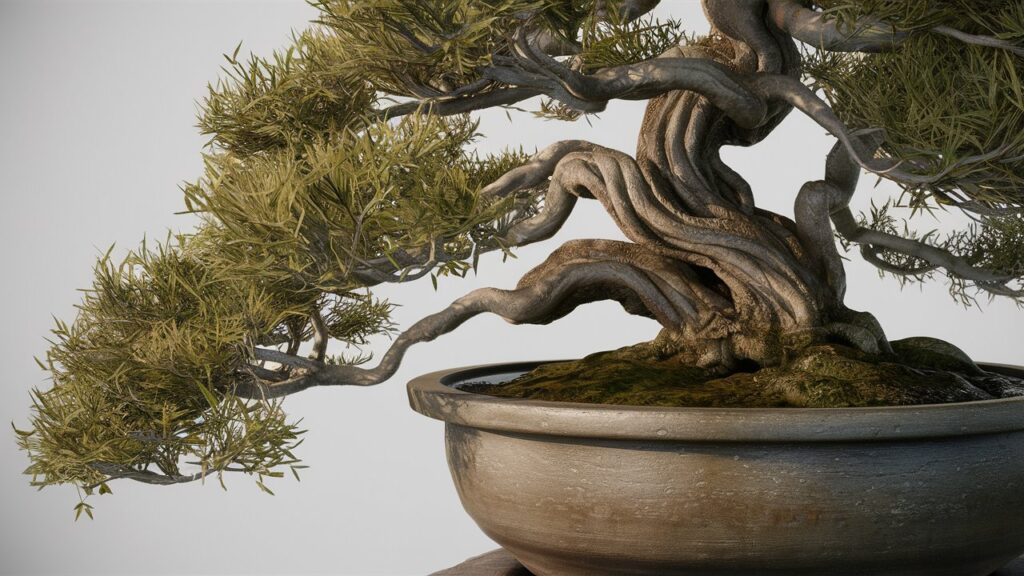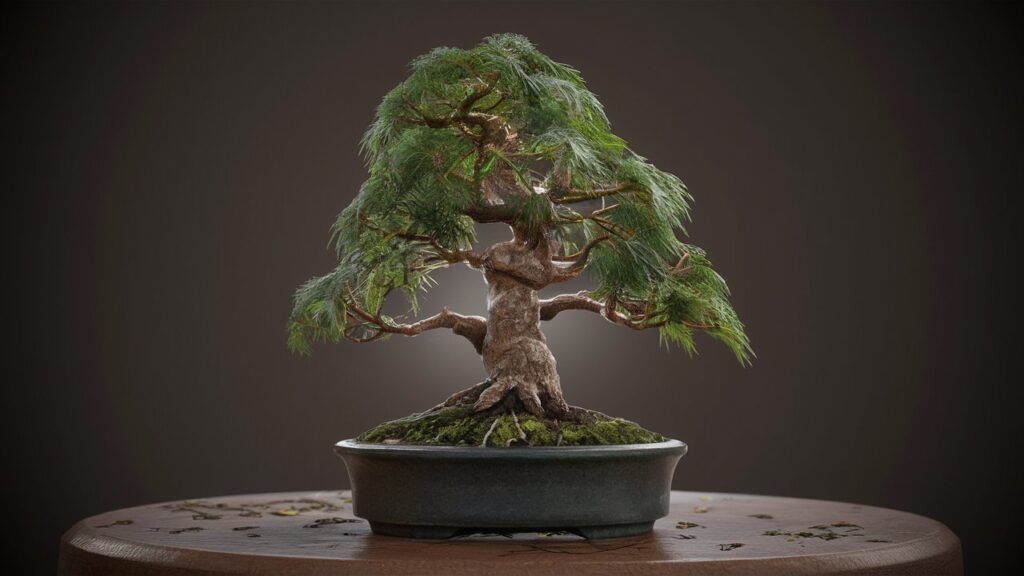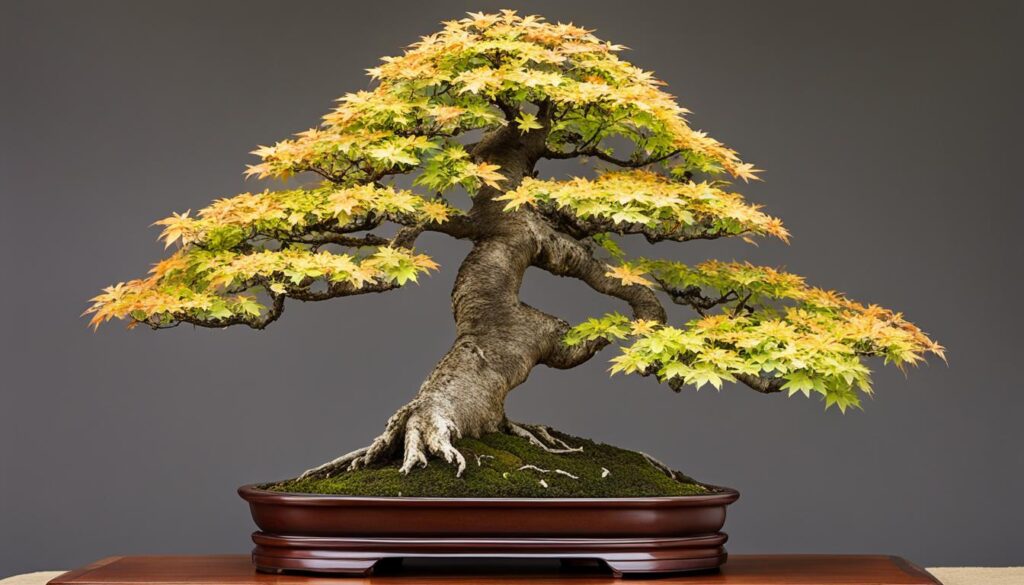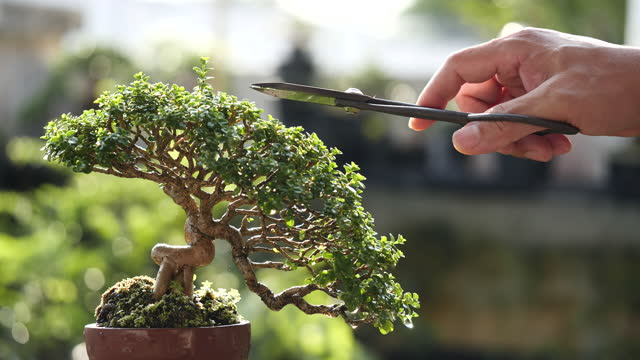The trident maple, with its iconic three-lobed leaves, is a bonsai superstar. This Asian native charms enthusiasts with its compact form, remarkable adaptability, and stunning seasonal displays. What sets it apart is its rapid growth rate, making it one of the fastest-developing bonsai species. This speed allows artists to quickly refine their vision, watching branches thicken and ramification develop in record time.
From its delicate spring buds to fiery autumn foliage, and bark that gains character with age, the trident maple offers year-round appeal. Its blend of beauty, versatility, and swift growth makes it an irresistible choice for bonsai artists of all levels.
Growing trident maple bonsai

Propagation
Propagating trident maples for bonsai offers enthusiasts multiple exciting avenues. Growing from seed is a rewarding, albeit patience-testing process, allowing artists to shape the tree from its earliest stages. Seeds typically require cold stratification to germinate, mimicking natural winter conditions. For those seeking quicker results, cuttings provide an efficient alternative. Softwood cuttings taken in summer often root readily, producing clones of the parent tree.
Air-layering, a technique where roots are encouraged to grow on a branch while still attached to the parent tree, is particularly effective with trident maples. This method allows for the creation of pre-branched specimens with mature bark characteristics, giving bonsai artists a head start in developing their miniature masterpieces.
Trunk development
Trident maples are prized in the bonsai world for their ability to rapidly develop thick trunks and impressive nebari (surface roots). This fast growth is a boon for artists looking to create mature-looking bonsai in a relatively short time. To capitalize on this trait, enthusiasts employ several techniques. Heavy pruning stimulates vigorous regrowth, while strategic defoliation forces the tree to redirect energy to trunk development. Aggressive fertilization, particularly in spring and fall, fuels this growth spurt.
These methods, when combined, can dramatically accelerate the thickening process, transforming a slender sapling into a stout, character-rich trunk in just a few growing seasons. The trident maple’s responsiveness to these techniques makes it an ideal species for bonsai artists eager to witness the rapid evolution of their living sculptures.
Leaf reduction

Trident maples are naturally blessed with relatively small leaves, a trait highly valued in bonsai. However, enthusiasts can further miniaturize this foliage to enhance the tree’s scaled-down appearance. Summer defoliation is a key technique, where leaves are carefully removed during the growing season, prompting the tree to produce a new set of smaller leaves. Pinching new growth is another effective method, encouraging ramification and reducing leaf size.
By consistently applying these techniques, bonsai artists can achieve remarkably diminutive foliage, creating a more proportionate and refined appearance that accentuates the tree’s miniature form. This malleability of leaf size, combined with the trident maple’s natural predisposition to smaller foliage, makes it an ideal species for creating highly detailed and realistic bonsai representations.
Ramification
Trident maples are highly responsive to bonsai techniques aimed at developing dense ramification, making them a favorite among enthusiasts seeking fine branching structure. Pruning plays a crucial role, with strategic cuts encouraging back-budding and the development of new shoots. Wiring allows artists to position branches precisely, creating the desired silhouette and spaces for new growth. Defoliation, when timed correctly, stimulates a burst of new buds and finer twigs.
The trident maple’s vigorous growth habit means it responds rapidly to these techniques, allowing bonsai practitioners to create intricate branch structures in relatively short time frames. This responsiveness, combined with the species’ natural tendency towards fine branching, enables artists to craft trees with impressively dense, delicate ramification that enhances the overall bonsai aesthetic.
Caring for trident maple bonsai

Watering
Trident maple bonsai, known for their vigorous growth, have a thirst to match their vitality. During the growing season, these trees require frequent attention to their water needs. The key is to strike a balance: water when the soil feels slightly dry to the touch, but never allow it to completely dry out. This delicate equilibrium supports healthy growth while avoiding issues like root rot from overwatering. Savvy bonsai artists recognize that watering isn’t a one-size-fits-all approach.
They adjust their watering routine based on several factors: the local climate, with hotter, drier conditions demanding more frequent watering; pot size, as smaller containers dry out faster; and the tree’s growth stage, with actively growing trees requiring more water than dormant ones. This adaptive approach to watering helps ensure trident maples maintain their lush foliage and robust health throughout the seasons.
Sun exposure
Trident maple bonsai thrive in full sun, soaking up the light to fuel their vigorous growth. However, like many plants, they have their limits. While these trees love basking in sunlight, the intense heat of scorching afternoon sun in summer can be too much of a good thing. Smart bonsai enthusiasts keep a watchful eye on the thermometer, ready to provide some relief when temperatures climb above 85-90°F (29-32°C).
Shade cloth becomes a valuable ally in these moments, offering a protective veil that filters the harshest rays while still allowing plenty of light through. Alternatively, temporarily relocating the tree to a spot with partial shade during peak heat hours can prevent leaf scorch and stress. This careful balance of sun exposure ensures trident maples maintain their lush, vibrant foliage throughout the hottest months, setting the stage for robust autumn colors and healthy winter dormancy.
Must Read: Japanese Maple Bonsai Growing and Care Guide
Temperature
Trident maple bonsai showcase remarkable resilience across a wide temperature range, but they do have their limits. With proper shading, these hardy trees can withstand scorching heat exceeding 100°F (38°C), maintaining their vigor even in sweltering conditions. However, when the mercury plummets, trident maples reveal their vulnerability. Temperatures dipping below 28°F (-2°C) can spell trouble, potentially causing dieback of branches and compromising the tree’s carefully crafted structure.
Savvy bonsai enthusiasts take precautions as winter approaches, often relocating their prized tridents to protected environments like greenhouses or cool rooms. This winter haven shields the trees from harsh freezes while still providing the necessary cold period for healthy dormancy. By respecting these temperature boundaries, bonsai artists ensure their trident maples emerge strong and vibrant each spring, ready for another season of growth and artistic refinement.
Fertilizing
Fertilizing trident maple bonsai is a nuanced practice that mirrors the tree’s natural growth cycles. During the growing season, these vigorous trees benefit from monthly feedings with organic or liquid fertilizers, fueling their rapid development. Bonsai artists often employ an aggressive fertilization strategy in spring and fall, capitalizing on these key growth periods to promote robust health and accelerate development. However, the approach shifts come summer and during periods focused on refining ramification.
At these times, fertilizer application is reduced or paused altogether. This strategic feeding schedule supports the tree’s natural rhythms while allowing for precise control over growth rates. By adjusting fertilizer timing and intensity, bonsai enthusiasts can alternately encourage vigorous growth for structural development and restrain it for fine-tuning delicate branching patterns, ultimately crafting a tree that’s both healthy and aesthetically refined.
Pruning and wiring
Pruning and wiring are essential techniques in shaping trident maple bonsai, each with its own timing and approach. Spring sees a flurry of new growth, prompting bonsai artists to prune judiciously, typically leaving just 1-2 leaf pairs on each shoot. This not only maintains the tree’s desired shape but also encourages finer branching. Throughout the growing season, selective pruning helps balance growth and prevents the die-back of inner twigs, ensuring a full, healthy canopy.
When it comes to wiring, fall and winter are prime times, as the leafless branches are more flexible and easier to manipulate. For older, thicker branches that resist traditional wiring, guy wires offer an effective alternative, allowing artists to gradually reposition stubborn limbs. This carefully timed regimen of pruning and wiring enables bonsai enthusiasts to sculpt their trident maples into living masterpieces, blending horticultural knowledge with artistic vision.
Repotting
Repotting is a crucial aspect of trident maple bonsai care, typically performed every 2-3 years to maintain optimal health and growth. The ideal time for this operation is early spring, just before the buds begin to swell with new life. Trident maples are remarkably resilient when it comes to root work, tolerating heavy pruning that would stress many other species. This tolerance allows bonsai artists to aggressively manage the root system, promoting fine root development and maintaining a compact root ball.
When repotting, enthusiasts opt for a well-draining soil mixture with a slightly acidic to neutral pH, ranging from 5 to 7. This soil composition ensures proper water retention while allowing excess moisture to escape, preventing root rot and promoting healthy growth. The combination of timely repotting, judicious root pruning, and appropriate soil selection sets the stage for vigorous growth and long-term health in trident maple bonsai.
Pests and diseases
Trident maple bonsai are renowned for their resilience, boasting relatively strong resistance to pests and diseases. However, vigilant care is still essential to maintain their health. While generally hardy, these trees can occasionally fall prey to common bonsai ailments. Aphids, scale insects, caterpillars, and spider mites may attempt to make a meal of the foliage, while fungal invaders like powdery mildew and leaf spot can mar the leaves’ beauty. Root rot poses a threat if soil drainage is poor.
To safeguard against these potential issues, bonsai enthusiasts employ a proactive approach, regularly inspecting their trees and addressing problems swiftly. One crucial practice is sealing wounds promptly after pruning or accidental damage, creating a barrier against opportunistic fungi. This combination of the trident maple’s natural resilience and the attentive care of its cultivator ensures that these bonsai specimens remain healthy, vibrant showpieces in any collection.
Conclusion
Trident maple emerges as a star in the bonsai world, prized for its rapid growth, small leaves, and responsiveness to bonsai techniques. Its versatility shines through various propagation methods and its ability to quickly develop thick trunks and dense ramification. Care involves a balance of sun exposure, regular watering, and strategic fertilization. Skilled pruning and wiring transform these trees into living art. While generally hardy, they benefit from winter protection and vigilant pest management. Repotting every few years in well-draining soil maintains their vigor. The trident maple’s blend of natural beauty and adaptability to bonsai practices makes it an excellent choice for enthusiasts of all levels, offering a rewarding journey in the art of miniature tree cultivation.



